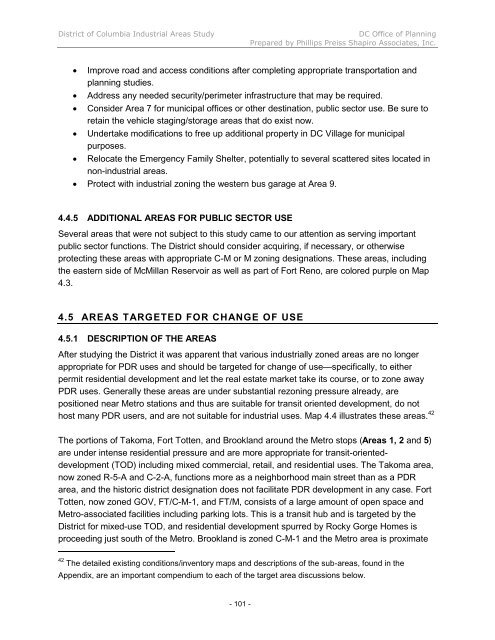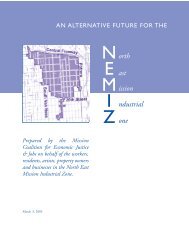INDUSTRIAL LAND IN A POST-INDUSTRIAL CITY District of ...
INDUSTRIAL LAND IN A POST-INDUSTRIAL CITY District of ...
INDUSTRIAL LAND IN A POST-INDUSTRIAL CITY District of ...
You also want an ePaper? Increase the reach of your titles
YUMPU automatically turns print PDFs into web optimized ePapers that Google loves.
<strong>District</strong> <strong>of</strong> Columbia Industrial Areas Study DC Office <strong>of</strong> Planning<br />
Prepared by Phillips Preiss Shapiro Associates, Inc.<br />
Improve road and access conditions after completing appropriate transportation and<br />
planning studies.<br />
Address any needed security/perimeter infrastructure that may be required.<br />
Consider Area 7 for municipal <strong>of</strong>fices or other destination, public sector use. Be sure to<br />
retain the vehicle staging/storage areas that do exist now.<br />
Undertake modifications to free up additional property in DC Village for municipal<br />
purposes.<br />
Relocate the Emergency Family Shelter, potentially to several scattered sites located in<br />
non-industrial areas.<br />
Protect with industrial zoning the western bus garage at Area 9.<br />
4.4.5 ADDITIONAL AREAS FOR PUBLIC SECTOR USE<br />
Several areas that were not subject to this study came to our attention as serving important<br />
public sector functions. The <strong>District</strong> should consider acquiring, if necessary, or otherwise<br />
protecting these areas with appropriate C-M or M zoning designations. These areas, including<br />
the eastern side <strong>of</strong> McMillan Reservoir as well as part <strong>of</strong> Fort Reno, are colored purple on Map<br />
4.3.<br />
4.5 AREAS TARGETED FOR CHANGE OF USE<br />
4.5.1 DESCRIPTION OF THE AREAS<br />
After studying the <strong>District</strong> it was apparent that various industrially zoned areas are no longer<br />
appropriate for PDR uses and should be targeted for change <strong>of</strong> use—specifically, to either<br />
permit residential development and let the real estate market take its course, or to zone away<br />
PDR uses. Generally these areas are under substantial rezoning pressure already, are<br />
positioned near Metro stations and thus are suitable for transit oriented development, do not<br />
host many PDR users, and are not suitable for industrial uses. Map 4.4 illustrates these areas. 42<br />
The portions <strong>of</strong> Takoma, Fort Totten, and Brookland around the Metro stops (Areas 1, 2 and 5)<br />
are under intense residential pressure and are more appropriate for transit-orienteddevelopment<br />
(TOD) including mixed commercial, retail, and residential uses. The Takoma area,<br />
now zoned R-5-A and C-2-A, functions more as a neighborhood main street than as a PDR<br />
area, and the historic district designation does not facilitate PDR development in any case. Fort<br />
Totten, now zoned GOV, FT/C-M-1, and FT/M, consists <strong>of</strong> a large amount <strong>of</strong> open space and<br />
Metro-associated facilities including parking lots. This is a transit hub and is targeted by the<br />
<strong>District</strong> for mixed-use TOD, and residential development spurred by Rocky Gorge Homes is<br />
proceeding just south <strong>of</strong> the Metro. Brookland is zoned C-M-1 and the Metro area is proximate<br />
42 The detailed existing conditions/inventory maps and descriptions <strong>of</strong> the sub-areas, found in the<br />
Appendix, are an important compendium to each <strong>of</strong> the target area discussions below.<br />
- 101 -












